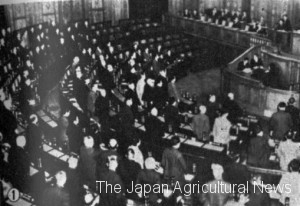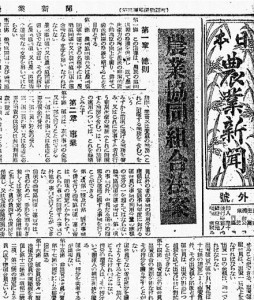Final draft presented after piled negotiation

Plenary session of House of Councillors at the enactment of Nogyokyodokumiai (agricultural cooperatives) Law (from the Appendices of “Nogyokyodokumiai (agricultural cooperatives) mutual aid evolution” by JA Zenkyoren (National Mutual Insurance Federation of Nogyokyodokumiai (agricultural cooperatives)))
The Ministry of Agriculture was forced to compromise on the draft of Nogyokyodokumiai (agricultural cooperatives) bill (first draft of GHQ) created by Division of Natural Resources responsible for the agricultural sector in Allied General Headquarters ( GHQ ) . The ministry created the fourth and fifth draft diluted the control color.
In the fifth draft, the ministry finally added the provision of “abolition of nogyodantai law (agricultural organization law) stipulating the terms of nogyokai (agricultural institution), and abolition of nogyo-jikko-kumiai (farming union).” Regarding establishment of cooperatives, the ministry added the provision stipulating 10 or more of cooperatives members as minimum number of founders (in the sixth draft and in the seventh draft, minimum number of founders was more than 7, but in the eighth draft, the number became more than 15 like current article). In addition, the draft stipulated that one board member could be elected from the associate members.

The article of the Nihon nogyoshinbun (The Japan Agricultural News) reporting the establishment of the Nogyokyodokumiai (agricultural cooperatives) Law. The Nihon nogyoshinbun issued the extra edition and reported the details.
On May 15, 1947, Division of Natural Resources of GHQ presented the second draft. This draft more specifically illustrated GHQ’s concept than the first draft. Feature of the draft was as follows;
1) more widely used many expressions that reflects cooperatives principle, 2) added principal of maximum service and non-profit, 3) one year of the term of office of board member and auditor.
The Ministry of Agriculture and Forestry incorporated this concept significantly and created the sixth draft in late of the month. This is said to be something that became the prototype of the Nogyokyodokumiai (agricultural cooperatives) Law of today.
In the later years roundtable discussion, Takekazu Ogura, former agricultural policy manager, received a question as “How was the way of receipt by Japanese side?” He answered, ” We followed as GHQ said at the time.”
GHQ added democracy
However, when the ministry delivered the draft to the deliberations of the Legislative Bureau in order to create the bill, the bureau shaped the form of law in Japanese-style, and swapped the position of chapters and sections widely. Due to this modification, the seventh draft was created. But this draft was refused by GHQ with significant dissatisfaction. GHQ immediately requested correction.
Modification points were fairly detailed. But the root of problem was clear because negotiation stage had been approaching to the end. And it remained to return the position of the chapters and sections to the sixth draft, and to correct the terms of description and lexical as follows;
1)Regarding the definition of farmers, to add the word of “themselves” such as ” People who themselves engaged in agriculture,” 2) to limit the qualification of associate member to “people who do not have qualification of ordinary member but have reasonable need to use the facilities of the cooperatives by living at the areas the cooperatives are doing business,” 3) to define the limit of the number of members able to represent at the General Assembly in the articles of incorporation at the case of cooperatives consist of more than 1000 ordinary members, without limiting it to one person.
The Eighth draft was completed. It is said to be the final draft of the Ministry of Agriculture and Forestry. In addition to the modification of the seventh draft, its feature of the draft was as follows;
1) minimum number of members are 15 people, 2) non-investment cooperatives can not carry out in conjunction with the loan business and savings acceptance business, 3) administrative agency can determine the model of Articles of Incorporation examples. The purpose of this Act was determined as “By promoting the development of farmers’ cooperative organizations, to promote agricultural productivity and economic and social empowerment of farmers, together with aiming for the development of the national economy”.
◇
Nogyokyodokumiai (agricultural cooperatives) bill was submitted in the first Diet in August 1947, Hiroo Wada Agriculture Minister explained the proposed reason. “It is urgent to compensate for the disadvantages that come from micro-management of the farmers and to improve streamlining of management and agricultural productivity by the force of cooperation,” In addition, he indicated that 1) to ensure freedom of subscription system of members and founding district of nogyokyodokumiai (agricultural cooperatives), 2) to admit the subscription of people other than the farmers, 3)to define cooperatives as the cooperatives body for agricultural production to deal the business such as facilities for development of land, management of water conservancy, and cooperation of the agricultural work, 4) to respect the autonomy of cooperatives and limit the supervision rights of administrative agency in a certain range.
The draft claimed that cooperatives, which were conformed to regulations and formed through the regular procedure, should be all approved.
Nogyokyodokumiai (agricultural cooperatives) Law, which was born based on agrarian reform, was promulgated on November 19, after the difficult process. It showed that there were strong conflicts regarding Agricultural Cooperatives Law between GHQ which put democracy.
Reference = “Nogyokyodokumiai (agricultural cooperatives) system history, the first volume and the second volume” JC Research Institute, Kentaro Uchikoshi and Takekazu Ogura “Establishment process of the Nogyokyodokumiai (agricultural cooperatives) Law” JC Research Institute, Keisuke Otake ” Phantom of the flower, life of Hiroo Wada” Agriculture and Forestry Statistics Publishing Inc.

